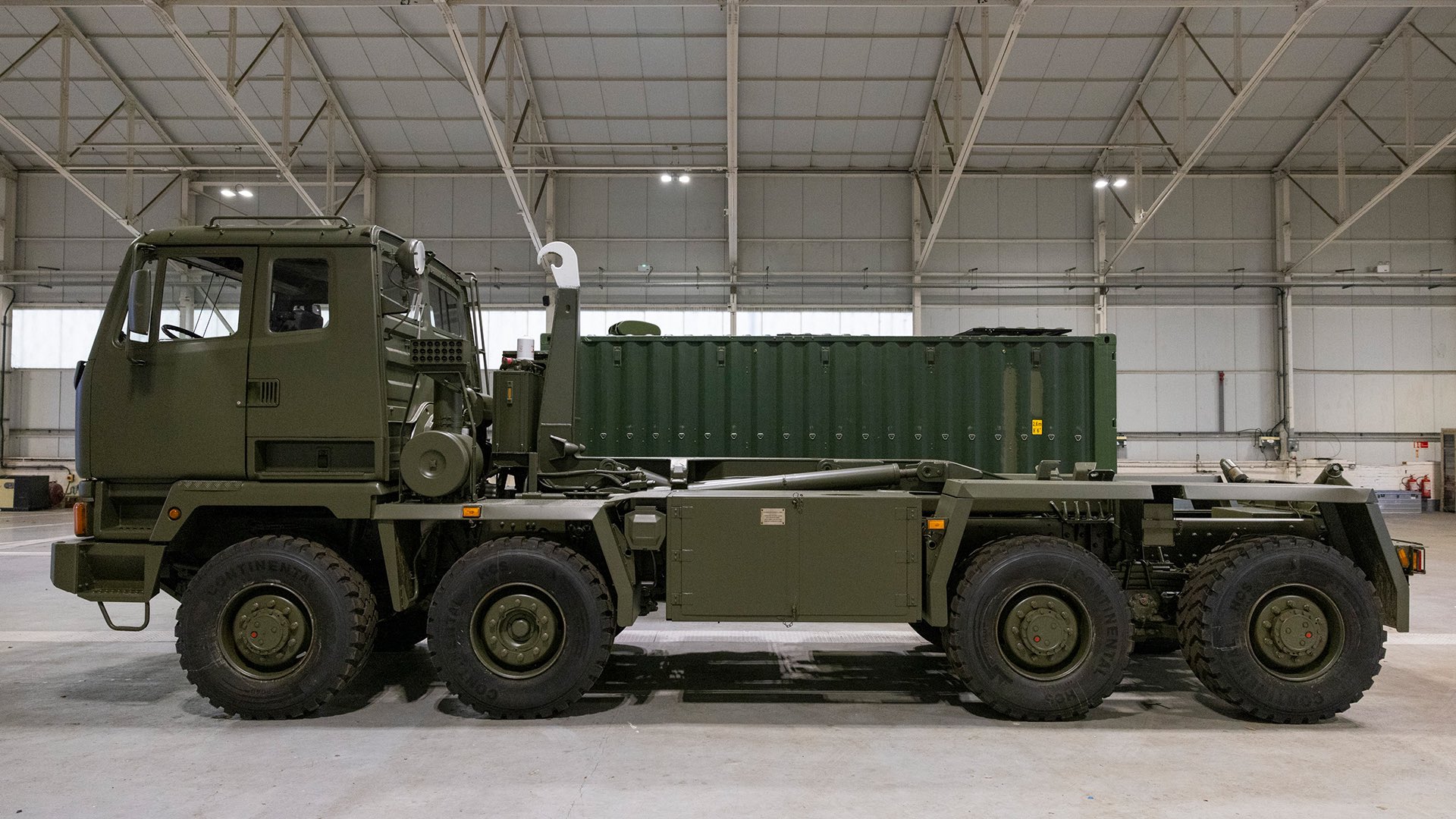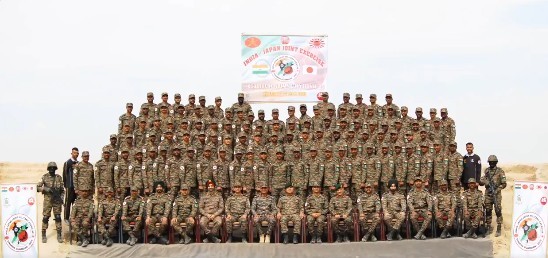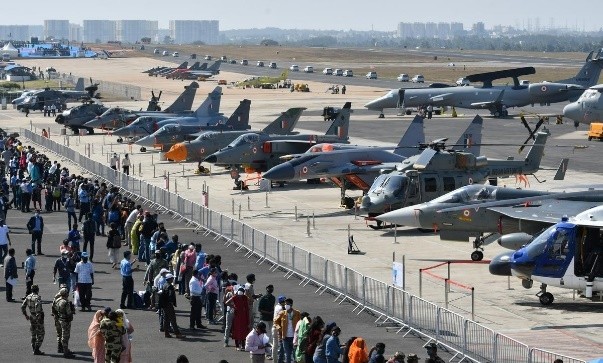Gravehawk Hybrid Air Defense System

- 20 Feb 2025
In News:
The Gravehawk is a newly developed mobile surface-to-air missile (SAM) system, introduced by the United Kingdom in collaboration with Denmark, to bolster Ukraine's defenses against Russian aerial threats. This innovative hybrid system exemplifies the modern trend in NATO of repurposing existing missile technology to build flexible, cost-effective, and rapidly deployable air defense platforms.
Overview and Development
- The Gravehawk system is designed to counter short-range aerial threats such as drones, cruise missiles, and low-flying aircraft.
- It combines Western and Soviet-era missile technologies, providing Ukraine with a unique edge in a contested aerial environment.
- The United Kingdom, in partnership with Denmark, is actively delivering these systems to Ukraine, with 15 additional units expected in the coming months.
- The cost per system is approximately USD 1.25 million, with Denmark covering 50% of the expense.
Key Features and Technical Capabilities
- Missiles Used: The system utilizes infrared-guided missiles including the AIM-132 ASRAAM (Advanced Short Range Air-to-Air Missile) and the Soviet-origin R-73 (AA-11 Archer).
- Guidance System: Both missiles employ passive infrared (IR) seekers, allowing them to track heat signatures of targets without emitting radar signals, thereby reducing vulnerability to electronic warfare (EW) detection.
- Speed and Range: Missiles can reach speeds of up to Mach 2.5 and engage targets at distances of approximately 12 miles (about 19 km).
- R-73 Specifics: Originally developed for close-range dogfights, the R-73 is highly maneuverable, capable of tracking targets up to 40 km ahead and 300 meters behind, with off-boresight targeting up to 40 degrees.
- Mobility: Mounted on all-terrain Drops vehicles, the system offers rapid ground mobility and deployment flexibility.
- Containerized Launch Platform: Housed in ISO-standard shipping containers, the system’s roof rolls back to expose two missile rails—repurposed from Soviet-era fighters like the Sukhoi Su-27.
- Crew and Operation: Operated by a five-member crew, the system incorporates electro-optical and infrared targeting cameras, enabling remote operation and safe standoff missile launches.
Strategic Relevance for Ukraine
- Ukraine’s acquisition of the Gravehawk system marks a significant advancement in its air defense capabilities, particularly in the face of persistent Russian air and missile attacks.
- It enhances short-range interception capacity, allows for quick reaction deployment, and reduces dependence on continuous NATO resupplies. Additionally, the system’s use of widely available R-73 missiles ensures operational sustainability.
- The Gravehawk is part of a broader effort to field "hybrid systems", where older missile stocks are integrated into modern platforms.
- Other such initiatives include FrankenSAM programs developed by the U.S. and UK, where systems like ASRAAM have been adapted to ground-based launchers.
- Ukraine has also employed R-73 missiles on drone boats and unmanned surface vessels to target Russian air assets, showcasing the multi-domain applicability of these munitions.
Prime Minister’s Yoga Awards 2025

- 20 Feb 2025
In News:
The Ministry of Ayush has officially opened nominations for the Prime Minister’s Yoga Awards 2025, which will be conferred on the occasion of the International Day of Yoga (IDY) 2025. These prestigious awards aim to honour individuals and organizations that have made exceptional and sustained contributions to the promotion and development of Yoga at both national and international levels.
Background and Objective
Instituted by the Government of India and endorsed by the Hon’ble Prime Minister, the awards recognize Yoga’s vital role in:
- Health promotion
- Disease prevention
- Management of lifestyle-related disorders
The initiative reflects the government’s broader vision to acknowledge and encourage meaningful contributions in advancing Yoga as a holistic system of well-being and preventive healthcare.
Award Categories and Benefits
The awards will be presented in the following four categories:
- National Individual
- National Organization
- International Individual
- International Organization
Each awardee will receive:
- A Trophy
- A Certificate of Recognition
- A Cash Prize of ?25 lakh
Eligibility Criteria
- Individual applicants must be 40 years or older.
- They should possess a minimum of 20 years of committed work in promoting Yoga.
- Organizations must have a proven track record in the field of Yoga development and outreach.
Applicants or nominees can apply for only one category (either National or International) in a given year. Applications can be submitted directly by individuals/entities or through nominations made by recognized Yoga institutions.
Application and Submission Process
- Nominations and applications are to be submitted through the MyGov platform:
https://innovateindia.mygov.in/pm-yoga-awards-2025/ - The link is also accessible on the Ministry of Ayush website and those of its autonomous bodies.
- The deadline for submission is March 31, 2025.
Selection Procedure
The award process involves two key stages:
- A Screening Committee formed by the Ministry of Ayush will evaluate all entries and recommend a maximum of 50 nominations per category.
- These shortlisted names will be reviewed by a high-level Evaluation Jury comprising eminent personalities from diverse fields, which will serve as the final decision-making body.
Significance of the Initiative
The Prime Minister’s Yoga Awards not only celebrate excellence in Yoga but also further the objectives of initiatives like Fit India Movement, Ayushman Bharat, and the mainstreaming of traditional Indian wellness systems.
The awards are a key element of the Ministry of Ayush’s broader mandate to integrate traditional systems such as Ayurveda, Yoga & Naturopathy, Unani, Siddha, Sowa-Rigpa, and Homeopathy into the healthcare ecosystem of India.
India–U.S. Underwater Domain Awareness Cooperation

- 20 Feb 2025
In News:
India and the United States have deepened their defense partnership by launching the Autonomous Systems Industry Alliance (ASIA), a landmark initiative focused on co-producing Underwater Domain Awareness (UDA) technologies in India.
Understanding Underwater Domain Awareness (UDA)
- UDA refers to the ability to monitor, detect, and evaluate activities beneath the surface of oceans and seas. It plays a vital role in ensuring maritime security, enabling anti-submarine warfare (ASW), managing marine resources, responding to disasters, and protecting the underwater environment.
- In the backdrop of China’s rapid naval expansion and its increasing footprint in the Indian Ocean Region (IOR), enhancing UDA has become imperative for India, both at the bilateral level and as part of the Quad framework (India, U.S., Japan, and Australia).
Strategic Significance and Geopolitical Relevance
The UDA collaboration marks a significant step in Indo-U.S. strategic relations. As the maritime domain becomes increasingly contested, especially in the Indo-Pacific, India’s need for robust submarine detection, surveillance, and underwater intelligence capabilities has become critical. The joint initiative aligns with broader strategic goals such as:
- Enhancing Quad cooperation to maintain a free, open, and secure Indo-Pacific.
- Countering threats arising from Chinese submarine activities and naval assertiveness.
- Enabling shared maritime patrols and airlift capacity for disaster response across the region.
Key Technologies Identified for Co-Production
Several high-end underwater surveillance systems have been identified for co-production or co-development in India under the ASIA framework:
- Sea Picket: An autonomous sonar surveillance platform developed by Thayer Mahan.
- Wave Glider Unmanned Surface Vehicles (USVs): Discussions are underway between Boeing’s Liquid Robotics and Sagar Defence Engineering for the co-production of 60 platforms in India.
- Low-Frequency Active Towed Sonar: Negotiations involve L3 Harris and Bharat Electronics Limited (BEL) for co-development.
- Multistatic Active (MSA) Sonobuoys: A sophisticated submarine-tracking technology, to be co-produced in India by Ultra Maritime and Bharat Dynamics Limited (BDL), with a production line expected by 2027.
- Large-Diameter Autonomous Undersea Vehicles: Produced by Anduril, these offer deep-sea monitoring capabilities.
- Triton Autonomous Underwater and Surface Vehicle: Developed by Ocean Aero, integrates underwater and surface operations.
Existing and Emerging ASW Platforms
India’s anti-submarine warfare capabilities have already been bolstered through U.S. defense acquisitions, including:
- 12 P-8I Poseidon maritime patrol aircraft currently in service.
- 24 MH-60R Multi-Role Helicopters, being inducted to enhance ASW and surveillance.
- 15 MQ-9B Sea Guardian UAVs, part of a 31-unit contract with deliveries beginning from 2029.
- An additional six P-8I aircraft were cleared during the recent bilateral talks.
These platforms significantly improve maritime interoperability among Quad nations and provide India with a strategic edge in underwater operations.
Make-in-India and Technological Sovereignty
The UDA initiative strongly supports India’s Atmanirbhar Bharat vision by fostering indigenous manufacturing of advanced underwater systems. It introduces a first-of-its-kind co-production framework in sensitive defense technologies, thus catalyzing innovation and industrial capability within the Indian defense sector.
The initiative also aims to strengthen logistics, intelligence-sharing, and force mobility between the Indian and U.S. armed forces. Enhanced training, joint operations, and technological exchanges will help sustain forward deployments and enable humanitarian and disaster relief missions across the Indo-Pacific.
Exercise Dharma Guardian 2025

- 20 Feb 2025
In News:
The 6th edition of Exercise Dharma Guardian, a joint annual military exercisealternately hosted in India and Japan since 2018is scheduled from February 25 to March 9, 2025, at Mount Fuji, Japan.
Key Highlights:
Objectives:
- Strengthen Bilateral Defence Relations: Enhances military diplomacy under the India–Japan Special Strategic and Global Partnership.
- Promote Interoperability: Develops joint operational capabilities and tactical synergy in line with UN peacekeeping mandates (Chapter VII).
- Urban and Semi-Desert Warfare: Trains troops in counter-terrorism operations and urban combat scenarios.
- Regional Stability: Supports the Indo-Pacific security architecture and complements Quad defence objectives (India, Japan, US, Australia).
Key Features of Dharma Guardian 2025
- Advanced Tactical Training: Close-quarter battle drills, live-fire exercises, battlefield medical evacuation.
- Joint Counter-Terror Operations: Conducted under UN charter guidelines for multinational cooperation.
- 48-hour Validation Exercise: Simulated real-time combat for assessing operational readiness and coordination.
- ISR and Tactical Mobility Drills: Involves establishing temporary operating bases, ISR (Intelligence, Surveillance, Reconnaissance) grids, mobile vehicle checkpoints, and heliborne insertions.
- House Intervention & Search Operations: Practical training for securing urban areas against militant threats.
- Weapons & Equipment Display: Demonstrates India’s growing defence manufacturing under the Atmanirbhar Bharat initiative.
Mount Fuji – Host Site
- Geographical Significance: Japan’s highest peak at 3,776.24 meters, located 100 km southwest of Tokyo.
- Cultural Importance: Recognized as a UNESCO World Heritage Site (2013) and revered as one of Japan’s “Three Holy Mountains.”
- Training Terrain: Its stratovolcanic landscape provides a realistic backdrop for high-altitude and rugged terrain operations.
Related India-Japan Military Exercises
India and Japan conduct a wide spectrum of bilateral and multilateral defense exercises across all services:
Exercise Name Service Branch Focus Area
Dharma Guardian Army Land-based counter-terror and urban warfare
JIMEX Navy Naval interoperability and maritime security
Malabar (Quad) Navy (Multilateral) Naval drills with US and Australia
Veer Guardian Air Force Air combat tactics and coordination
ShinyuuMaitri Air Force Air mobility and humanitarian operations
Aero India 2025

- 20 Feb 2025
In News:
Aero India 2025, the 15th edition of Asia's largest biennial airshow, is scheduled to take place from February 10 to 14, 2025, at the Air Force Station, Yelahanka, in Bengaluru, Karnataka.
Organized by the Defence Exhibition Organisation under the Ministry of Defence, with support from HAL, DRDO, and the Indian Air Force, the event showcases India's growing prowess in aerospace, aviation, and defense technologies.
Key Highlights:
Edition: 15th (First held in 1996; originally Avia India in 1993)
Theme: “The Runway to a Billion Opportunities”
Conclave Theme: “BRIDGE – Building Resilience through International Defence and Global Engagement”
Objectives and Significance
- Promote Indigenous Manufacturing: In alignment with ‘Make in India’ and ‘Atmanirbhar Bharat’, the show promotes domestic aerospace and defense production.
- Showcase Technological Advancements: Cutting-edge systems including fighter jets, helicopters, UAVs, and AI-integrated defense solutions will be exhibited.
- Encourage Global Partnerships: Facilitates joint ventures, MoUs, and technology transfers between Indian and foreign defense firms.
- Boost Strategic Diplomacy: A platform for global defense ministers, CEOs, and military leaders to foster bilateral and multilateral defense ties.
- Stimulate Investment: Attracts FDI and international contracts in India’s defense sector.
Key Events
- Live Aerial Displays: Aerobatic performances by combat aircraft, helicopters, and elite teams like Surya Kiran.
- Defense Ministers’ Conclave: Deliberations on enhancing international defense cooperation.
- CEO Roundtable: Industry leaders discuss emerging trends and investment prospects.
- Manthan/iDEX Pavilion: Showcasing start-up innovations in defense and aerospace.
- India Pavilion: A dedicated zone for indigenous defense production and capabilities.
- International Seminar (Feb 8–9): Focused on Futuristic Aerospace Technologies and related R&D challenges.
Strategic Role of Aero India
Aero India plays a pivotal role in:
- Supporting Medium Multi-Role Combat Aircraft (MMRCA) procurements.
- Demonstrating India's readiness as a global defense manufacturing hub.
- Enhancing India’s geopolitical standing by fostering defense diplomacy through multilateral engagement.
